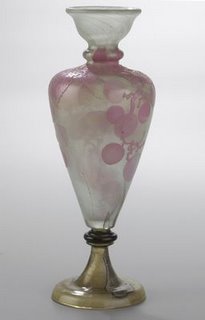New Art Donated to the Orsay
 Emile Gallé, Vase with grape decoration, shown at the Exposition universelle de Paris, 1900, image by Patrice Schmidt, courtesy of the Musée d'Orsay, donation Rispal, 2005 |
This treasury has been donated by the wife and daughter of a hotel owner, Antonin Rispal, who died in 2003. Born in 1920 in the Auvergne, the long-time owner of the Mars Hôtel, on the Avenue de La Bourdonnais in Paris, had a passion for the "1900 style." In the 1950s, he began to collect things at flea markets and second-hand shops. The objects that he sought were not worth much at the time. That was how he accumulated a large collection in all areas of decorative art: furniture, glass, bronze, ceramic. His collection became so large that, in order to house it better, he opened a boutique at the Village Suisse, next door to his hotel. [...]Not that we needed another reason to go back to Paris, but we have one.
Architects, painters, sculptors, decorators: all reacted at the same time against the industrial leveling out of formes and the eclectic taste then dominant. Curves, volutes, floral motifs, and the glorification of nature were their trademark. For them, there was no hierarchy among the arts, which it was necessary first to imagine as a way of understanding the world. Artists undertook painting in the same way as book binding, design the same as metalwork or glass -- and let's not forget architecture, the summa of an entire way of living. This globalizing approach would be taken up, between the world wars, by the German Bauhaus group, founded by the architect Walter Gropius in Weimar in 1919.
Thanks to the Rispal donation, the Musée d'Orsay can reinforce its strong points. For example, the wood carving and ceramic of the Nancy school, with Emile Gallé (1846-1904), Louis Majorelle (1859-1926), and Jacques Gruber (1870-1936). It also allows the filling in of some lacunae, with the furniture of Carlo Bugatti (1856-1940). Furthermore, the bronzes, ceramics, glass, stained glass windows, lamps, furniture of lesser-known artists like Paul Follot (1877-1942), creator of wall paper, book bindings, furniture, jewelry, stained glass, and even a small house in Paris, on the Rue Schoelcher, allow the museum to give a more precise idea of what the period produced. The Rispal gift also allows the museum, because of what it has from the years 1907 to 1910, to explain the transition from Art Nouveau to Art Deco, which came to the fore following World War I.





















































No comments:
Post a Comment